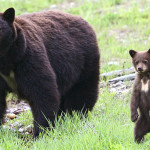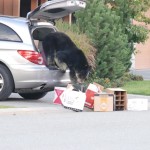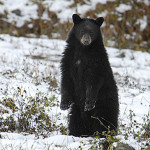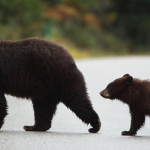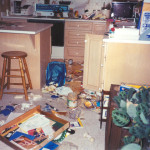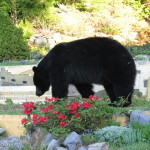A Bigger Picture for Bears and Humanity
There is no picture. Nope, not even if this was a social media post. And no, this wasn’t an editorial decision. There is no picture to accompany the story. That’s the point.
I was riding along West Side Road. I had already climbed Kadenwood and Nordic, my mind emptied of the usual worries and to do lists. I was staring at a blank road so to speak, so when I turned a corner and saw a vehicle flashing its lights at me, I didn’t clue in at first.
I was a few pedal strokes away from a large black bear.
She was beautiful. Brown with a wide face. Fifteen years in Whistler, and the thrill of seeing a wild animal like this never lessens. But what locked this memory in was the sound of her eating. What joy. She was chowing down on a green something with such relish. Mouth open, bits and pieces flying about as she mashed. It was the sound of a toddler eating creamy pasta for the first time. That lip-smacking, I-can’t-get-this-in-me-fast-enough sound. I only heard this in the few seconds of lost pedal strokes, coasting by this special scene.
I didn’t stop. I didn’t turn around. My phone was well within reach in my jersey back. I could have photographed the moment, but I decided to live it instead, taking the time to absorb this chance gem as I pedalled away. I didn’t snap a photo. So I got to see, feel and hear things I would have otherwise missed fiddling with a phone.
Now there are plenty of reasons not to stop and view and/or photograph a bear from the side of the road.
The Conservation Office Service will be the first to tell you it is illegal to endanger other motorists by stopping your car on a provincial or municipal road.
Bear advocates will tell you that by giving a bear a positive experience with a human (a.k.a. a human quietly watching a bear at a close proximity posing absolutely no threat to the bear) only leads to that bear becoming overly comfortable around people. Every encounter a bear has with humans matters because these instances have a way of piling up on each other. Once accustomed to people’s presence, bears grow more and more emboldened with every encounter. It isn’t long before they decide it’s OK to enter public spaces; and therefore, said bear becomes a dead bear.
These are two solid arguments. One arises out of the need to protect the safety of others, the other to preserve the welfare of the bears.
Still, there’s a third. It’s purely selfish—although motorists and bears benefit. Do it for yourself—your own wellbeing.
Hours have passed since my roadside encounter, and I can still hear and see the old girl chomping down clearly in my head. It’s an inner picture that will find me, or be one that I’ll look to when I need a smile. I think nature and the outdoors are more powerfully realized when the picture lives inside of you.
And if you don’t agree, I’ll leave you with an old saying: a picture is a worth a thousand words.
The picture I’m thinking about was from a recent social media feed on the royal wedding. The image was of a cheering crowd, holding up a wall of cell phones in front of them, save one grey-haired, old lady who leaned on a barrier, contentedly watching and smiling at the royal couple driving by, enjoying the moment.
And if you still can’t kick the need for something to post on your social media feed, I urge you to be a good human and steal.
Feel free to drag and drop any bear image from bearsmart.com, leaving you free to experience what should be a passing, but not fleeting, moment with our bears.


